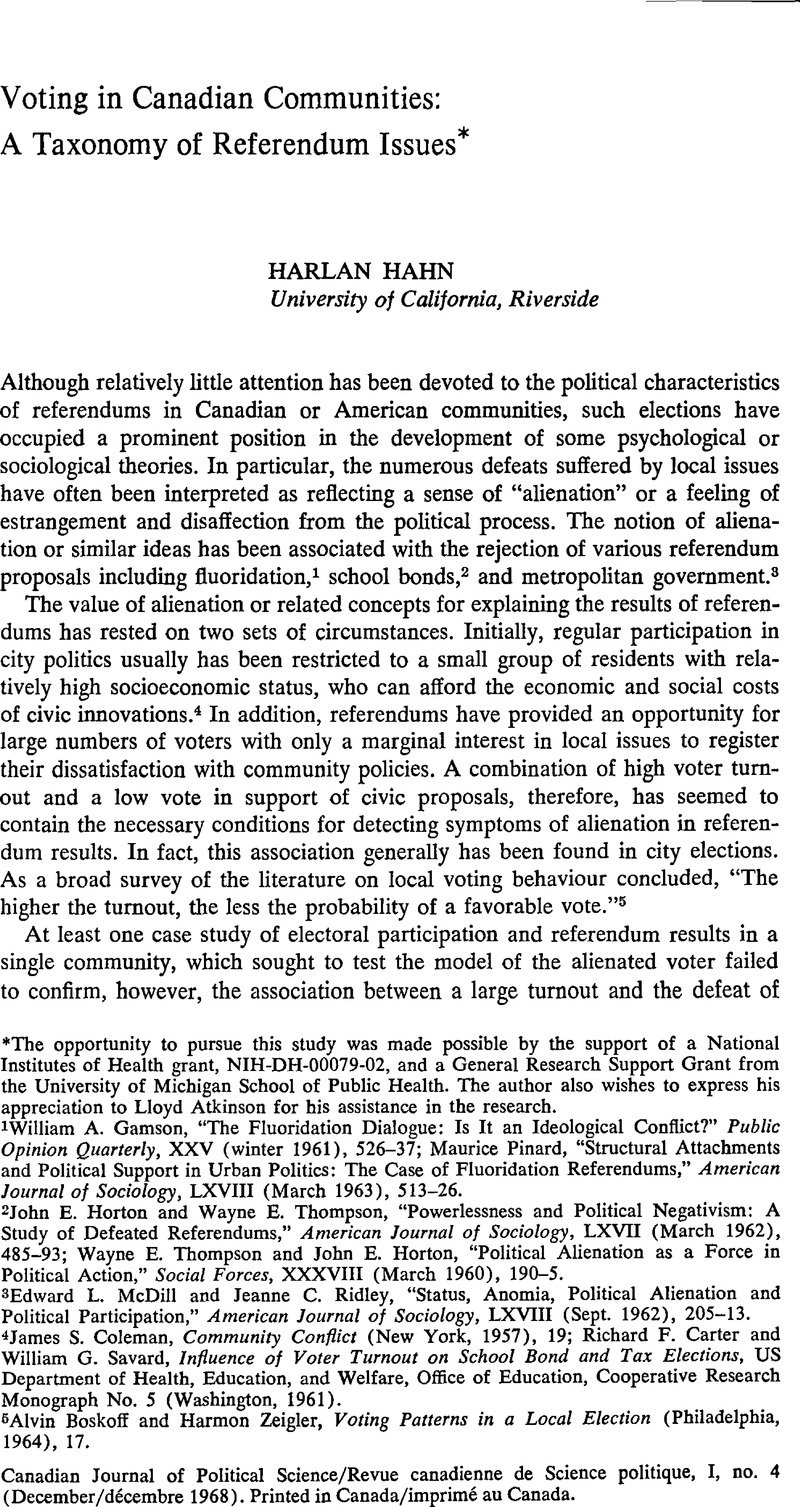Article contents
Voting in Canadian Communities: A Taxonomy of Referendum Issues*
Published online by Cambridge University Press: 10 November 2009
Abstract

- Type
- Articles
- Information
- Canadian Journal of Political Science/Revue canadienne de science politique , Volume 1 , Issue 4 , December 1968 , pp. 462 - 469
- Copyright
- Copyright © Canadian Political Science Association (l'Association canadienne de science politique) and/et la Société québécoise de science politique 1968
References
1 Gamson, William A., “The Fluoridation Dialogue: Is It an Ideological Conflict?” Public Opinion Quarterly, XXV (winter 1961), 526–37CrossRefGoogle Scholar; Pinard, Maurice, “Structural Attachments and Political Support in Urban Politics: The Case of Fluoridation Referendums,” American Journal of Sociology, LXVIII (March 1963), 513–26.CrossRefGoogle Scholar
2 Horton, John E. and Thompson, Wayne E., “Powerlessness and Political Negativism: A Study of Defeated Referendums,” American Journal of Sociology, LXVII (March 1962), 485–93CrossRefGoogle Scholar; Thompson, Wayne E. and Horton, John E., “Political Alienation as a Force in Political Action,” Social Forces, XXXVIII (March 1960), 190–5.CrossRefGoogle Scholar
3 McDill, Edward L. and Ridley, Jeanne C., “Status, Anomia, Political Alienation and Political Participation,” American Journal of Sociology, LXVIII (Sept. 1962), 205–13.Google Scholar
4 Coleman, James S., Community Conflict (New York, 1957), 19Google Scholar; Carter, Richard F. and Savard, William G., Influence of Voter Turnout on School Bond and Tax Elections, US Department of Health, Education, and Welfare, Office of Education, Cooperative Research Monograph No. 5 (Washington, 1961).Google Scholar
5 Boskoff, Alvin and Zeigler, Harmon, Voting Patterns in a Local Election (Philadelphia, 1964), 17.Google Scholar
6 Stone, Clarence N., “Local Referendums: An Alternative to the Alienated-Voter Model,” Public Opinion Quarterly, XXXIX (summer 1965), 221.Google Scholar
7 Ibid., 222.
8 The author wishes to express his appreciation to Mrs. B. Isabel Brown of the Bureau of Economic Research, Canadian Dental Association, and to Mr. Lloyd H. Bowen of the National Fluoridation Committee, Health League of Canada, for their assistance in preparing and verifying this list.
9 Scarrow, Howard A., “Patterns of Voter Turnout in Canada,” Midwest Journal of Political Science, V (Nov. 1961), 351–64.CrossRefGoogle Scholar
10 “Nation-wide Survey on Municipal Voting in Canada's Cities and Towns,” unpublished paper, Canadian Federation of Mayors and Municipalities (Montreal, 1957).
11 see, for example, Metz, A. Stafford, “An Analysis of Some Determinants of Attitude toward Fluoridation,” Social Forces, XLIV (June 1966), 477–84CrossRefGoogle Scholar; Hahn, Harlan, “Fluoridation and Patterns in Community Politics,” Journal of Public Health Dentistry, XXV (fall 1965), 152–7.CrossRefGoogle Scholar
12 See, for example, Wilson, James Q. and Banfield, Edward C., “Public-Regardingness as a Value Premise in Voting Behavior,” American Political Science Review, LVIII (Dec. 1964), 876–87.CrossRefGoogle Scholar
13 “Stone, “Local Referendums,” 222.
- 5
- Cited by




